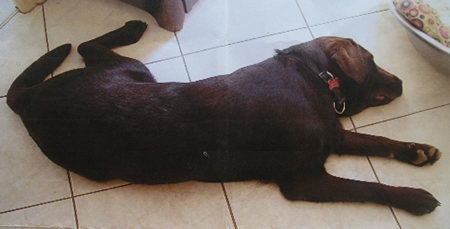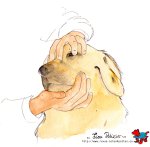The last article was about physiological torsion which meant to introduce dissymmetry in the pelvis and the whole body.
Let’s recall that according to this concept, the quadruped left iliac bone, and its sacro-iliac joint orientation, is more enclined to a forward and upward rotation, on the opposite: the right iliac bone woud rotate easier backward and downward.
This dissymmetric vision of the body allows to greatly simplify treatments and to better understand some diseases.
Though, unless performing good training of this perception and actually observing the results, it is sometimes difficult to understand comings and goings of this concept, which we can not observe on our own.
Actually, compensations are generaly so close to one another in the body that this torsion stays unnoticed. By luck, the young growing dog emphasizes and sometimes worsens his osteopathic dysfunctions.
As a young veterinarian, I saw a puppy in consultation who was walking like a crab, I found nothing explaining this and could not help him. The local bonesetter did help him and what’s more in a few seconds...
It is only, while learning Fryette’s rules which deals with vertebral rotations that I understood this particular case.
Now, this young growing labrador, with bad stands, an arched back, suspected with hip dysplasia is seen in osteopathy.
Osteopathic diagnosis, treatment and results are here, quite classic : high Medullar Traction Force, increased Physiological Torsion. The result in a few days is good : disappearance of broken movements, and of the arched back.
But, what is interesting in this case, is a small common detail, which, us, veterinarians, would sweep away as an artefact if we did not know Physiological Torsion concept.
A detail, in fact, questionned the owner right from the beginning : his puppy never lies straight in a ’sphinx’ position as most dogs do. When he wants to lie down as shown on the picture, he rotates his back side towards the left.

And one can recognise there, a torsion dysfunction with a right iliac stuck downwards and a left one stuck upwards. In these conditions, the sphinx position pushes the right iliac bone to rise, as this is not possible, the bone takes the easiest way and the confortable position chosen here results in a downwards right iliac and allows the left iliac bone to go even further in its easier position.
A few days after the treatment, the puppy starts lying down spontaneously in a sphinx position.
Thus, this type of little detail is usefull to any therapeut, knowing or not osteopathy and its last progress, one just has to look and listen. And, in an even more acute observation as this increased torsion, leading the left femur bone to internal rotations and the right one to external rotations, enhances appearance of coxo-femoral dysplasia... and this is the real story.
This is part of the facts which have to be put in official understanding of dysplasia instead of exclusively trying to look for a tricky genetic bringing up dysplasia one day and none the next one...



